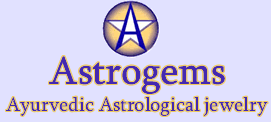 |
 |
| |
|
Frequently Asked Questions My Vedic astrologer suggested I get a substitute gem instead of the more expensive one. What do you think of this? Vedic astrologers have extensive skills in analyzing the planetary deficiencies that need strengthening in the chart. They have for the most part selected their substitute system based on the less expensive and far more readily available gems. As yet, I have not read what I consider an authoritative source for deciding what the substitutes are and how well they work. I am satisfied that the primary gems came from the rishis, but who decided upon the substitutes? Edgar Cayce recommended gems and stones to individuals but his non Vedic gems were never specifically prescribed for a single planetary focus. I have a deep respect for his legacy. But, unfortunately, though I have read his pioneering work many times, his reference to substitutes is not covered. I have had my chart done many times and when it has come to the area of substitute gems the advice has been very wide and varied. Though astrologers can differ widely on which stone to recommend as a substitute, this is not to say that the stones are not highly beneficial. My first Vedic astrologer strongly recommended that I get a blue topaz. As a gemologist I already knew that natural blue topaz is so rare it is virtually non existent on the market. What he didn't know was that he was advising that I wear a topaz that had been nuclear irradiated with gamma rays which had changed its electron structure in such a way that it will trap the blue rays of light in the spectrum. Neutron or electron bombardment is also common to change Topaz color. The US Customs has often in past years turned back blue topaz coming from Brazil because it had a too high radioactive reading with their Geiger counters! As I had this reading in India, and having traveled that land widely, I have never seen a blue topaz there that has not been enhanced by radiation. Citrine is often advised instead of yellow sapphire. Very few realize that most citrine is smoky quartz or low quality amethyst that has been heat treated in a Brazilian kiln to turn it yellow. Golden topaz often shares the same procedure. Many times I have seen people wearing laboratory grown amethyst or quartz thinking it naturally occurring. Goldstone has been recommended as a substitute, being a misnomer it is in fact always glass with copper filings in it and does not exist naturally. A diamond is 140 times harder than its next hardest neighbor, a white sapphire, yet some recommend it as a diamond substitute. White sapphire is very often heat treated to melt out inclusions. Doesn't it make sense that it would be closer to the influence of a light yellow sapphire? So you see there is a definite need to clarify the knowledge influencing these substitute recommendations. When time allows, I look forward to doing a research project using some very high-tech computers and biofeedback machines to help indicate substitutes. But time as always waits for no one. Many people disagree with my stand concerning the laboratory-grown crystal emerald and ruby, and instead promote their dubious and not universally accepted substitutes. There is an immediate reaction that these gems are man-made. But this is not the case. The laboratory is the environment that allows the gem crystals to grow using Divine Mother Nature's laws of creation to develop. Is there really that much difference between a wild-grown vegetable and one grown in a laboratory greenhouse? I try to bring my detractors to analyze the scientifically measurable similarities that one can refer to on the charts. If you try to compare the substitutes tourmaline or peridot to an emerald using the same scientifically measurable characteristics on these charts, you will find that these stones have few similarities. They do have a green color range. And of course color is important. But of far more importance is the crystal habit. The difference of the crystal is as pronounced as the pyramid is to the cube. And that is how I relate to the differences in substitutes. This is not to say the tourmaline or the peridot are not wonderful gems to wear, but I question whether they actually come close to harmonizing with the planetary radiations they are supposed to replace. What I try to do when a client wants the gem but can not afford the high price is get the same stone with a good weight and clarity, but tumble polished. True, it certainly doesn't look as attractive, but primarily we are aiming at an instrument of karmic mitigation, not just cosmetic appeal. I sell substitute gems but feel happier when the client has both sides of the story. Return to Frequently Asked Questions |
